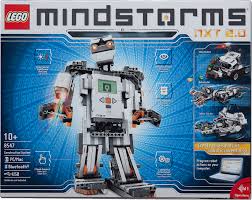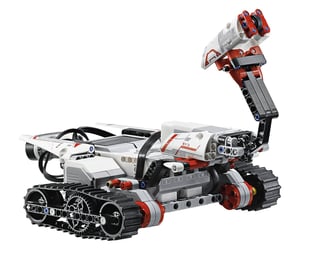Did Lego Mindstorms Inspire a Generation of Roboticists?

Posted on Feb 02, 2016 7:00 AM. 7 min read time
Without doubt, robotics owes a lot to the Lego Mindstorms kit. Over the years, this simple collection of Lego pieces and its brick-shaped microcontroller must have inspired hundreds of children to choose a career in robotics. What is Lego Mindstorms and why is it important for robotics education? In this post, we look at this seminal toy and find out where it came from.

Lego Mindstorms must have started more aspiring engineers on their journey to a career in robotics than any other toy. I say this not just because it's Lego's highest selling kit, but I speak from personal experience. I received my Lego Mindstorms kit at around 12 years old, the same age that I decided "I want to do robotics when I finish school." Though I had been interested in robots before, this kit took my love of robotics to another level.
Even while researching this post, I can still feel a child-like buzz of excitement as I watch YouTube videos of some of the jaw-droppingly cool robots that people have built with just a simple set of interlocking, plastic bricks and a pre-packaged microcontroller.
Why was Lego Mindstorms such a good start for teaching me (and others) about the basics of robotics?
It seems that the kit's success as a learning tool is no accident. It started with an inspiring educational theorist called, Seymour Papert,
and a simple programming language called LOGO.
But, before that was the Lego brick.
Lego Inspires Young Engineers
Lego has been training our future engineers for decades. Just as the basic Lego kits taught children to understand structural integrity and geometry, Lego Mindstorms taught a whole generation of roboticists how to make robots that actually work.
This year, the company has just announced a brand new robot kit aimed at schools, called WeDo 2.0. This is kind of a "Lego Mindstorms Light" aimed at children of Kindergarten age. Will this allow the next generation of roboticists to start their education even earlier? Let's hope so.
The original Lego Mindstorms kit arrived in 1998. Although Lego gears and pneumatics had been around for longer, in the form of Lego Technic, Mindstorms introduced programming and electronics for the first time.
What is Lego Mindstorms?
In case you somehow missed Lego Mindstorms when it first came out, I'll explain what the kits include.
The Brick
The main functionality of Mindstorms was (when I had it) provided by the bright yellow RCX. This was an 8-bit microcontroller with 32kB RAM and 16kB ROM wrapped up like a giant Lego brick. In newer kits, the technology has advanced quite a lot. The latest EV3 brick now has over 200 times the memory capacity, a microSD slot, Bluetooth and an ARM9 core.

As professional roboticists, it's very easy for us to just "order a higher-spec model" to deal with the limitations of our electronics hardware. However, this approach wasn't available to us as children. We had to learn to be inventive with the resources that were given to us in the kit. The original Mindstorms hardware was actually very limited, but the huge number of truly impressive inventions made by kids (an adults) shows how effective the kit was at teaching creative engineering.
Lego has also been very flexible when it comes to 'hacking' their products, which has undoubtedly contributed to its success. As a kid, I had already learnt some BASIC programming when I got my Mindstorms kit. It wasn't long before I'd given up the simple, LabView-based graphical programming language provided, jailbroken the RCX and installed NQC (Not Quite C), which allowed me to write more powerful programs.
The Sensors and Motors
These days there are a whole array of sensors you can use with Mindstorms. However, in the original kit there was only a light sensor, two switches and two motors. It's amazing how complicated you can make your robots with only these three sensors. Again, this was one of the strengths of the kit. It is important that aspiring roboticists learn how to work with such limitations creatively to develop their essential robotics skills like problem-solving and critical thinking.
The Rest - Lego Bricks
The majority of the kit was simple Lego bricks and Lego Technic pieces (which allowed for movement). If you ever played with Lego as a kid (or similar kits like Meccano), you'll recognize how such simple pieces can teach a lot about engineering. Even though the focus of Mindstorms was on the programming, it is undoubtedly the flexibility of the Lego bricks themselves which caused it to inspire so many creative robots.
Perhaps the true power of the original Mindstorms kit was that it was relatively limited. It didn't have loads of sensors but those which it did have were able to be used in hundreds of different ways. It forced the child to be creative and look for novel solutions, which is exactly the attitude you need to be a good roboticist.
Mindstorm's Predecessors - Turtle Bots and LOGO
It turns out that Lego Mindstorms was born thanks to the ideas of professor Seymour Papert from the MIT Media Lab. In 1984, the then CEO of Lego, Kjeld Kirk Kristiansen, saw Papert controlling small "turtle" robots using a simple programming language called LOGO. Papert was revolutionary when he proposed that computers and coding could be used to teach students. His theories of education said that "people learn effectively through making things." Kristiansen was inspired by the turtle robots and the Media Lab and Lego set up a long partnership which produced the RCX brick over a decade later. Papert also continues to advise Lego about the Mindstorms product range.
Do you remember the LOGO programming language? This "turtle-based drawing" stage was often the introduction to a coding education, for many of us it was our first formal experience with programming concepts. Little did we realize the importance of this simple language, as we sat in school classrooms directing our on-screen turtles to move "FW 100" then "RT 45".
LOGO was a key component to Papert's ideas about education. As an older teenager, I always wondered "What's the point of this language?" when we used it in Computer Science classes. As I had already programmed robots (with Mindstorms) it seemed silly to just draw lines on the screen when I could be controlling a robot to navigate the corridors. It turns out that the point of the language was simply - to learn through doing.
Without realizing it, I was undergoing exactly the sort of learning that Papert intended as I directed my on-screen turtles to draw a variety of silly shapes (simultaneously learning about subroutines, geometry and procedural programming).
His theories of project based learning carried through into the Mindstorms products themselves, which were named after Papert's book "Mindstorms: Children, Computers and Powerful Ideas."
The Future of Educational Robotics
There are now hundreds of kits which claim to teach children about the basics of robotics. Some popular ones last year included: Sphero (an app-controlled ball), Cubelets (modular robotic cubes) and MiP (a humanoid top with inverted-pendulum locomotion).
I might be biased, but to me many of the new offerings look more like ready-made toys than the original Mindstorms kit, which was very much about building and creating. Even the new Lego Mindstorms seems to be a little more focused on high-level control for a few pre-designed models than it is on invention.
However, you just need to search on YouTube to see that people are still getting really inventive with Lego Mindstorms. Hopefully these kits will continue to inspire young roboticists and produce a new wave of talented engineers.
Did you use Lego Mindstorms or LOGO? What skills do you think these kits teach children about robotics? Which educational robots do you prefer? Tell us in the comments below or join the discussion on LinkedIn, Twitter or Facebook.




Leave a comment